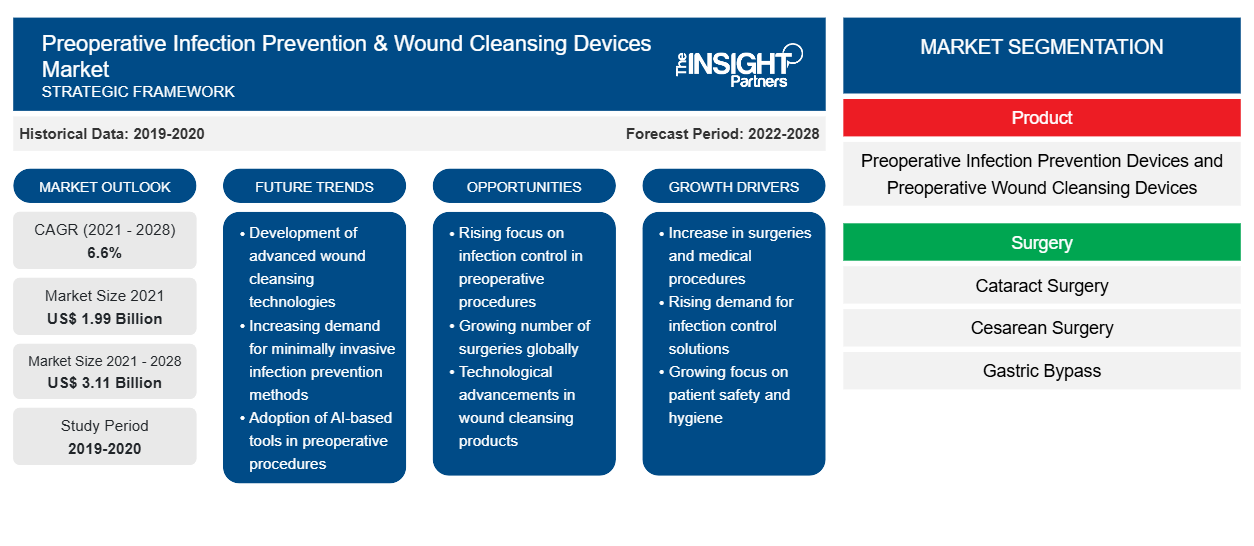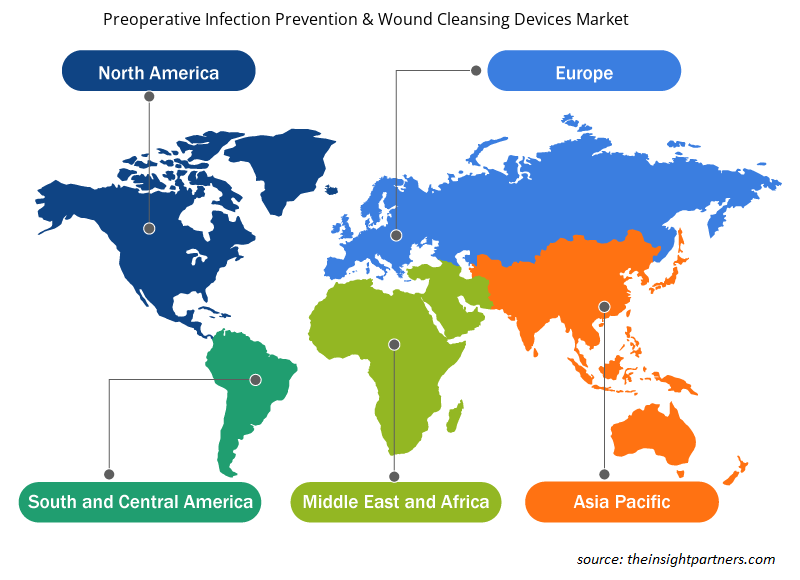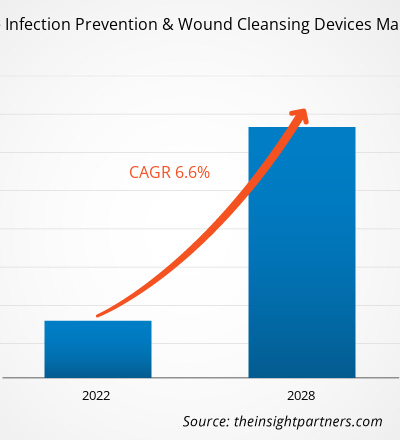Se espera que el mercado de dispositivos de prevención de infecciones preoperatorias y limpieza de heridas crezca de US$ 1.994,75 millones en 2021 a US$ 3.112,36 millones en 2028; se estima que crecerá a una CAGR del 6,6% entre 2022 y 2028.
El mercado de dispositivos de prevención de infecciones preoperatorias y limpieza de heridas está segmentado en función del producto, la cirugía, la aplicación y las regiones. El informe ofrece información y un análisis profundo del mercado, haciendo hincapié en diversos parámetros como la dinámica, las tendencias y las oportunidades en el mercado y el análisis del panorama competitivo de los principales actores del mercado en varias regiones. También incluye el análisis del impacto de la pandemia de COVID-19 en las regiones.
Perspectivas del mercado
La creciente incidencia de infecciones adquiridas en hospitales impulsa el crecimiento del mercado
Los centros de salud en varios países en desarrollo, como India y Japón, plantean un riesgo de infección para los pacientes. En los hospitales, las infecciones causan sufrimiento innecesario y la muerte de millones de pacientes cada año. Asia-Pacífico es una fuente de enfermedades infecciosas emergentes, incluidos organismos resistentes a múltiples fármacos (MDR) y patógenos con potencial pandémico. Los riesgos de enfermedades infecciosas emergentes en la región son complejos y se cree que involucran procesos ambientales, socioeconómicos y tecnológicos que favorecen la dinámica de la transmisión microbiana. Según estimaciones de los Institutos Nacionales de Salud, el riesgo de infecciones adquiridas en el hospital (HAI) en Asia-Pacífico es de 2 a 20 veces mayor que en los países desarrollados, y hasta el 25% de los pacientes hospitalizados informan infecciones. Según los Centros para el Control y la Prevención de Enfermedades (CDC), en los EE. UU., aproximadamente 1 de cada 31 pacientes en hospitales sufre al menos una HAI en un día determinado. Según los datos proporcionados por PatientCareLink, solo en los hospitales estadounidenses, las IAAS son responsables de aproximadamente 1,7 millones de casos de infección y 99.000 enfermedades asociadas cada año, de las cuales el 22% son infecciones del sitio quirúrgico.
Los centros de atención médica en países de ingresos bajos y medios tienen tasas de infecciones asociadas a la atención médica excepcionalmente altas, posiblemente debido a los desafíos adicionales para lograr un control efectivo de las infecciones, la falta de limpieza en los hospitales y la falta de concienciación sobre el control de las infecciones. Los pacientes gravemente enfermos son susceptibles a las infecciones asociadas a la atención médica en los países industrializados y en desarrollo. Un aumento en los casos de infecciones asociadas a la atención médica ha impulsado la necesidad de dispositivos de prevención de infecciones preoperatorias, lo que impulsa el crecimiento del mercado de dispositivos de prevención de infecciones preoperatorias y limpieza de heridas.
Personalice este informe según sus necesidades
Obtendrá personalización en cualquier informe, sin cargo, incluidas partes de este informe o análisis a nivel de país, paquete de datos de Excel, así como también grandes ofertas y descuentos para empresas emergentes y universidades.
Dispositivos de limpieza de heridas y prevención de infecciones preoperatorias: perspectivas estratégicas

-
Obtenga las principales tendencias clave del mercado de este informe.Esta muestra GRATUITA incluirá análisis de datos, desde tendencias del mercado hasta estimaciones y pronósticos.
Perspectivas basadas en productos
Según el producto, el mercado de dispositivos de prevención de infecciones preoperatorias y limpieza de heridas se segmenta en dispositivos de prevención de infecciones preoperatorias y dispositivos de limpieza de heridas preoperatorias. El mercado del segmento de dispositivos de prevención de infecciones preoperatorias se segmenta aún más en suministros de prevención de infecciones, dispositivos desechables de desechos médicos y equipos de prevención de infecciones. En 2021, el segmento de dispositivos de prevención de infecciones preoperatorias tuvo una mayor participación de mercado. Además, se prevé que el mismo segmento registre una CAGR más alta en el mercado durante 2022-2028. La prevención de infecciones perioperatorias requiere equipo técnico, buenas técnicas quirúrgicas e higiene adecuada. La base para esto es un departamento bien estructurado y bien organizado con procesos rutinarios conocidos y practicados generalmente y un cronograma sólido y realista. La prevención de infecciones posoperatorias en el sitio quirúrgico (SSI) es ahora más crítica que nunca. Los Centros de Servicios de Medicare y Medicaid (CMS) ya no reembolsarán a los centros de atención médica por SSI en múltiples cirugías. Las infecciones asociadas con la atención médica (HAI) son una preocupación importante y creciente para los sistemas de atención médica.
Perspectivas basadas en la cirugía
Según la cirugía, el mercado de dispositivos de prevención de infecciones preoperatorias y limpieza de heridas se segmenta en cirugía de cataratas, cirugía de cesárea, bypass gástrico, apendicectomía, colectomía y colostomía, esofagectomía, biopsia, colecistectomía, mastectomía, cirugía estética y otras. En 2021, el segmento de cirugía estética tuvo la mayor participación de mercado. Sin embargo, se espera que el mercado del segmento de cirugía de cataratas crezca al ritmo más alto durante el período de pronóstico. La cirugía estética incluye la reconstrucción de defectos faciales y corporales resultantes del parto, quemaduras, enfermedades y traumatismos. En la India, la popularidad de los procedimientos cosméticos ha aumentado significativamente debido a la creciente prevalencia de la obesidad, el creciente envejecimiento de la población y la creciente influencia de la cultura occidental. Además, debido al clima tropical del país, la demanda de tratamientos antienvejecimiento está aumentando. Corea del Sur se considera la capital de la cirugía estética en Asia Pacífico. Además, se espera que mantenga el dominio durante los próximos años. Con el paso de los años, el aumento de la demanda de estiramientos faciales, el aumento del gasto en mejoras estéticas y la disponibilidad de procedimientos avanzados han impulsado la demanda de procedimientos cosméticos en toda Corea del Sur. Las infecciones de las heridas se encuentran entre las complicaciones posoperatorias más comunes en los pacientes que se someten a una cirugía estética. Un asesoramiento preoperatorio adecuado ayudaría a establecer las expectativas correctas y, en última instancia, mejoraría los resultados y la satisfacción del paciente.
Perspectivas basadas en aplicaciones
Según la aplicación, el mercado de dispositivos de prevención de infecciones preoperatorias y limpieza de heridas se segmenta en depilación preoperatoria, preparación de la piel preoperatoria, solución de irrigación de heridas intraoperatorias y otros. En 2021, el segmento de depilación preoperatoria tuvo la mayor participación del mercado. Además, se espera que el mercado del mismo segmento crezca al ritmo más alto durante el período de pronóstico. Según las pautas de la Organización Mundial de la Salud (OMS), el vello no debe eliminarse a menos que interfiera con la cirugía. Según el informe de The Cochrane Collaboration, antes de una intervención quirúrgica, es común eliminar el vello de la zona del cuerpo que se va a operar. Los pelos se eliminan para evitar problemas durante y después de la cirugía. Por ejemplo, al suturar heridas o aplicar vendajes, los estudios afirman que la eliminación del vello podría causar infecciones después de la cirugía y debe evitarse.
Dispositivos para la prevención de infecciones preoperatorias y limpieza de heridas
Perspectivas regionales del mercado de dispositivos de limpieza de heridas y prevención de infecciones preoperatorias
Los analistas de Insight Partners explicaron en detalle las tendencias y los factores regionales que influyen en el mercado de dispositivos de limpieza de heridas y prevención de infecciones preoperatorias durante el período de pronóstico. Esta sección también analiza los segmentos y la geografía del mercado de dispositivos de limpieza de heridas y prevención de infecciones preoperatorias en América del Norte, Europa, Asia Pacífico, Medio Oriente y África, y América del Sur y Central.

- Obtenga datos regionales específicos para el mercado de dispositivos de limpieza de heridas y prevención de infecciones preoperatorias
Alcance del informe de mercado sobre dispositivos de limpieza de heridas y prevención de infecciones preoperatorias
| Atributo del informe | Detalles |
|---|---|
| Tamaño del mercado en 2021 | 1.990 millones de dólares estadounidenses |
| Tamaño del mercado en 2028 | US$ 3,11 mil millones |
| CAGR global (2021-2028) | 6,6% |
| Datos históricos | 2019-2020 |
| Período de pronóstico | 2022-2028 |
| Segmentos cubiertos |
Por producto
|
| Regiones y países cubiertos |
América del norte
|
| Líderes del mercado y perfiles de empresas clave |
|
Densidad de actores del mercado de dispositivos de limpieza de heridas y prevención de infecciones preoperatorias: comprensión de su impacto en la dinámica empresarial
El mercado de dispositivos de prevención de infecciones preoperatorias y limpieza de heridas está creciendo rápidamente, impulsado por la creciente demanda de los usuarios finales debido a factores como la evolución de las preferencias de los consumidores, los avances tecnológicos y una mayor conciencia de los beneficios del producto. A medida que aumenta la demanda, las empresas amplían sus ofertas, innovan para satisfacer las necesidades de los consumidores y aprovechan las tendencias emergentes, lo que impulsa aún más el crecimiento del mercado.
La densidad de actores del mercado se refiere a la distribución de las empresas o firmas que operan dentro de un mercado o industria en particular. Indica cuántos competidores (actores del mercado) están presentes en un espacio de mercado determinado en relación con su tamaño o valor total de mercado.
Las principales empresas que operan en el mercado de dispositivos de prevención de infecciones preoperatorias y limpieza de heridas son:
- Salud Cardenal Inc.
- Compañía 3M
- Bactiguard AB
- Becton Dickinson y compañía
- Getinge AB
Descargo de responsabilidad : Las empresas enumeradas anteriormente no están clasificadas en ningún orden particular.

- Obtenga una descripción general de los principales actores clave del mercado de dispositivos de limpieza de heridas y prevención de infecciones preoperatorias
Los actores del mercado de dispositivos de prevención de infecciones preoperatorias y limpieza de heridas adoptan estrategias orgánicas, como el lanzamiento y la expansión de productos, para expandir su presencia y cartera de productos en todo el mundo y satisfacer la creciente demanda. Las estrategias de crecimiento inorgánico observadas en el mercado son las asociaciones y colaboraciones. Estas estrategias de crecimiento han permitido a los actores del mercado expandir sus negocios y mejorar su presencia geográfica. Además, las adquisiciones, las asociaciones y otras estrategias de crecimiento ayudan a fortalecer la base de clientes de la empresa y a aumentar su cartera de productos.
- En mayo de 2021, Medline anunció el lanzamiento de un nuevo producto, los paños ReadyPrep CHG. Este nuevo producto, desde su lanzamiento, posee una participación de mercado nacional del 40 % en un lapso de dos años.
- En octubre de 2018,3M anunció una solución avanzada para la preparación de la piel en cirugías que beneficia la prevención de infecciones en los pacientes. El nuevo producto aprovecha la experiencia de 3M en tecnología de polímeros y adhesivos en forma de una "Película protectora 3M Prep" patentada. Posee una gran capacidad para permanecer en la piel del paciente y puede soportar los rigores de las condiciones quirúrgicas simuladas, incluida la limpieza repetida.
Perfiles de empresas
- Salud Cardenal Inc.
- Compañía 3M
- Bactiguard AB
- Becton Dickinson y compañía
- Getinge AB
- BioMerieux SA
- Industrias Medline Inc.
- Corporación Dynarex
- Soluciones de atención sanitaria Careon Pvt Ltd
- Steris S.A.
- Análisis histórico (2 años), año base, pronóstico (7 años) con CAGR
- Análisis PEST y FODA
- Tamaño del mercado, valor/volumen: global, regional y nacional
- Industria y panorama competitivo
- Conjunto de datos de Excel
Informes recientes
Testimonios
Razón para comprar
- Toma de decisiones informada
- Comprensión de la dinámica del mercado
- Análisis competitivo
- Información sobre clientes
- Pronósticos del mercado
- Mitigación de riesgos
- Planificación estratégica
- Justificación de la inversión
- Identificación de mercados emergentes
- Mejora de las estrategias de marketing
- Impulso de la eficiencia operativa
- Alineación con las tendencias regulatorias






















 Obtenga una muestra gratuita para - Mercado de dispositivos de prevención de infecciones preoperatorias y limpieza de heridas
Obtenga una muestra gratuita para - Mercado de dispositivos de prevención de infecciones preoperatorias y limpieza de heridas